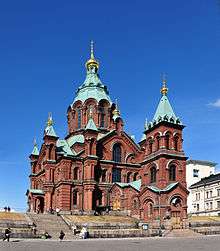Uspenski Cathedral, Helsinki
| Uspenski Cathedral | |
|---|---|
|
Finnish: Uspenskin katedraali Swedish: Uspenskij-katedralen Russian: Успенский собор | |
 | |
| 60°10′06″N 024°57′36″E / 60.16833°N 24.96000°ECoordinates: 60°10′06″N 024°57′36″E / 60.16833°N 24.96000°E | |
| Location | Helsinki |
| Country | Finland |
| Denomination | Eastern Orthodox |
| Website |
hos |
| History | |
| Consecrated | 1868 |
| Architecture | |
| Functional status | Active |
| Architect(s) | Aleksey Gornostayev |
| Architectural type | Cathedral |
| Administration | |
| Diocese | Helsinki |
Uspenski Cathedral (Finnish: Uspenskin katedraali, Swedish: Uspenskij-katedralen, Russian: Успенский собор, Uspenskij sobor) is an Eastern Orthodox cathedral in Helsinki, Finland, dedicated to the Dormition of the Theotokos (the Virgin Mary). Its name comes from the Old Church Slavonic word uspenie, which denotes the Dormition. Designed by the Russian architect Aleksey Gornostayev (1808–1862). The cathedral was built after his death in 1862–1868.
The crypt chapel of the cathedral is named after the holy Alexander Hotovitzky, who served as vicar of the Orthodox parish of Helsinki 1914–1917.
The Cathedral is set upon a hillside on the Katajanokka peninsula overlooking the city. On the back of the cathedral, there is a plaque commemorating Russian Emperor Alexander II, who was the sovereign of the Grand Duchy of Finland during the cathedral's construction. Main cathedral of the Finnish Orthodox Church in the diocese of Helsinki, Uspenski Cathedral is claimed to be the largest orthodox church in Western Europe.[1]
In 2006, about 516,500 tourists visited the church.[2] Admission to the Cathedral is free of charge. In winter, the Cathedral is closed on Mondays.[3]
Icon theft
The cathedral has several valuable icons, among others St. Nicolas – The Wonder Maker, which was stolen on 16 August 2007 between midday and 1 p.m. in broad daylight while hundreds of tourists were visiting the cathedral. The icon is from the 19th century and is of a rare variant. Originally it was given to the Orthodox Cathedral of Vyborg, from where it was moved to Helsinki during the Second World War. No further details of its origin are known.[4] The icon, being 45 by 35 centimetres (18 in × 14 in), was placed in a kiota (a glass covered protection frame) and weighs a couple of kilograms. It was on display on a lectern. The icon is now being searched for in Finland as well as abroad.[5]
Another icon, Theotokos of Kozeltshan was stolen in June 2010, but recovered in February 2011.[6]
References
- ↑ "Orthodoxy in Finland, Past and present" (ed. by V. Purmonen) (1984) p.74.
- ↑ Helsingin Sanomat, July 9, 2007.
- ↑ Uspenski Cathedral tourist information by the City of Helsinki.
- ↑ Precious icon stolen from Helsinki’s Uspenski Cathedral in broad daylight. Helsingin Sanomat August 17, 2007.
- ↑ Kainuun Sanomat, August 17, 2007, p. A7.
- ↑ "Thief tells police where stolen icon was hidden". Helsingin Sanomat. 2011-02-09. Retrieved 2011-08-20.
External links
| Wikimedia Commons has media related to Uspenski Cathedral. |
- Panorama picture of the Uspenski Cathedral (Helsinki)
- Helsingin ortodoksinen seurakunta (home page of the Uspenski Cathedral parish, in Finnish language)